The Second Ave Subway: An Introduction
Ask an old time New Yorker about the many great myths about the city and you’ll hear the standard ones about alligators in the sewers, rats the size of cats, and up until a few years ago even a subway that the city built under 2nd Ave but boarded up. The Second Ave subway was for a very long time vaporware (a computer term for software that is always talked about but never seems to become a reality.) I’ve touched on some of the history of the Second Ave subway in previous posts and much has been written about the subway over time. From my previous post:
The most famous, or infamous, part of the Second System was a 4 to 6 track trunk subway running from the Harlem River to Pine St in downtown. It may seem obvious for the need for a second subway line through the east side of Manhattan today but at the time there were actually 3 lines, the Lexington Ave subway and two elevated trains running up 3rd and 2nd Aves. The reason that the Second Ave subway was put off for so long was because the east side was already well served until the 1940s and 1950s when the elevated lines were torn down.
Because plans for the Second Ave line have been around for so long they have been subject to much change. Originally the line was to be a two track subway from Downtown until Houston St where a second set of tracks joined until 61st St where a planned connection to the 6th Ave line was to come in on another set of tracks, bringing the total tracks through to Harlem to six. Here the line would continue on to the Bronx as 4 tracks. The idea was for a super-express line that would connect to the 6th Ave line. It is interesting to note that in the original plans there were no connections from Queens.
The line was first proposed back in 1929, weeks before the stock market crashed and sent the nation into the Great Depression. Construction started twice on the line over the years, most recently in 2007. That’s a long time of waiting and dashed hopes. Lets put that into some perspective:
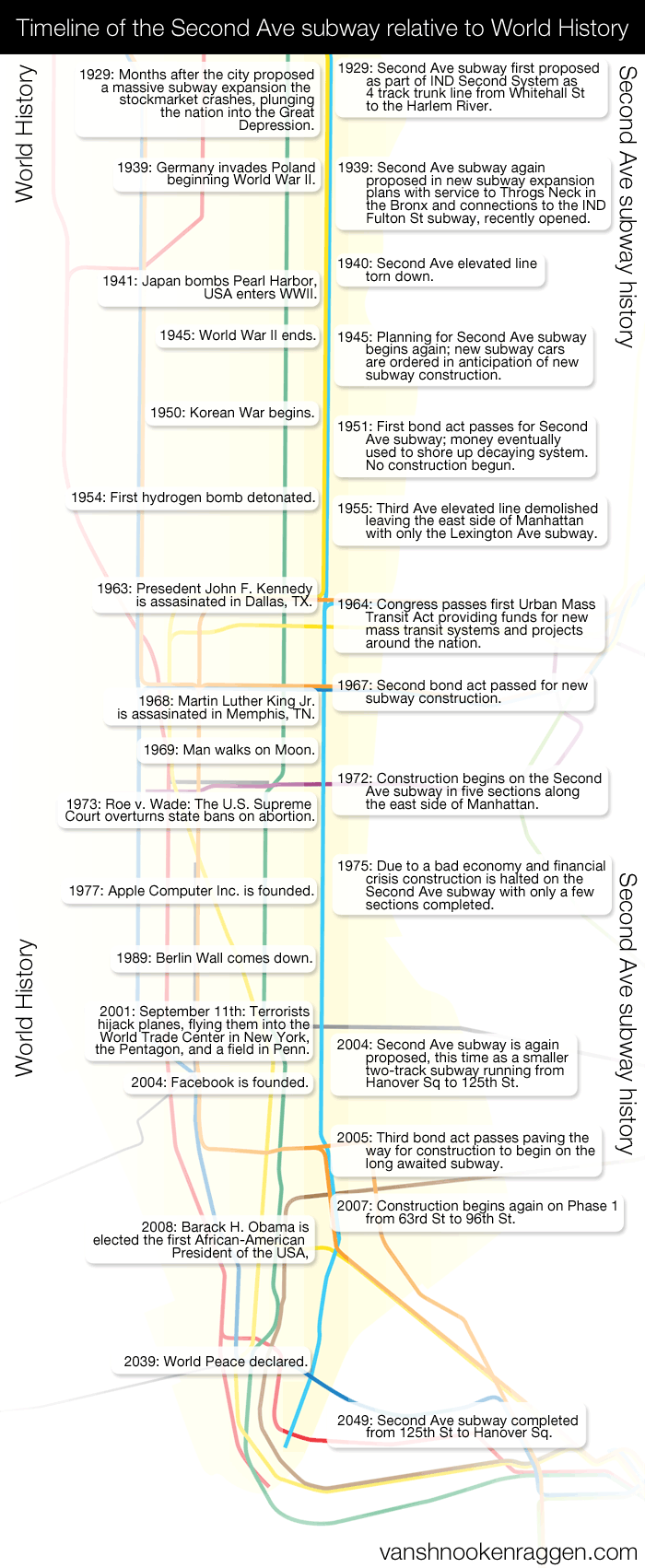
A more detailed timeline can be found over at SecondAveSagas.com, a blog set up originally to track progress on the line but now deals with all things MTA (one of the best blogs on the subject IMHO).
The need for a subway under 2nd Ave seems obvious today but one of main reasons that subways under 8th and 6th Aves were constructed first was due to the fact that at the time (1920-30s) mass transit in Manhattan was lopsided in favor of the East Side. A number of elevated lines ran up through Manhattan, on 9th Ave, 6th Ave, 3rd Ave and 2nd Ave. The 6th Ave elevated line combined with the 9th Ave at 53rd St meaning that residents of the West Side only had one elevated line while residents on the East Side had two. This is one reason the original subway (in 1904) ran through the Upper West Side, not the Upper East (until the Lexington Ave subway was opened in 1918). Two decades of residential growth along the Upper West Side meant that the city, when planning their Independent (IND) subway, focused on the West Side over the East.
But the point of building a subway wasn’t just to alleviate congestion, it was also primarily to allow for the destruction of the much hated elevated lines that darkened streets, threw dirt and trash on pedestrians below, made living near one a painful and dangerous experience, and kept real estate values down (this being New York that last one was a major factor.) Because two elevated lines ran through the East Side the city soon set its sights on transforming this half of the city like it had done on the West Side. So in 1929 the city announced plans for a major subway expansion that focused on a new trunk line running under 2nd Ave that would alleviate congestion and allow for the elevated lines to come down.
The original proposal called for a subway with four tracks (express and local) from the Harlem River to 125th St, six tracks from 125th St to 61st St (for super-express service), four tracks from 61st St to Chambers St, and finally two tracks from Chambers St to Wall St. Back at 61st St the additional set of tracks for super-express would cut off to the west to 6th Ave where they would connect to the 6th Ave line (a rare section of the Second Ave subway which was eventually constructed and is todays F Line). At the Harlem River the four track subway would head into the South Bronx up to Melrose where the line would split into two, two track lines, one which would run to Throgs Neck and the other which would run to Eastchester (click here to see the full description). It should be noted that at this time there were no plans to connect the line to any Brooklyn or Queens lines.
Due to the Great Depression the line was shelved but ten years later the plans were dusted off and reproposed. In the 1939 plan the line would be simpler, a four track line from Throgs Neck to Melrose, Bronx, then south to 2nd Ave in Manhattan to just south of Hanover Sq in Downtown where it would make a sharp turn east and head into Brooklyn under the East River to connect with the IND Fulton St subway at Hoyt-Schermerhorn (or more acuaratly, at Court St which is today the New York Transit Museum, but was at the time an active subway station). The plans at the time show the IND Fulton St subway (A,C) continuing further into South Jamaica and connecting to the Rockaways so one assumes that these extensions may have connected to the Second Ave subway. An interesting note about the 1939 plan is that the 61st St connection between the 6th Ave and 2nd Ave subways is no longer a direct connection, instead there would be a second East River tunnel at about 72nd St which would connect the 6th Ave subway with the Queens Blvd subway in Long Island City. This connection was eventually constructed, but further south at 63rd St.
With the nation coming out of the Great Depression and World War II winding down, New York City was, arguably, at the zenith of its might and prestige. Over the next decade the city threw itself into transforming itself into a new world capital and city of the future. It says something about American culture that throughout the government spending of the 1930s New Deal and the post War urban renewal/highway building boom that not a mile of new subway was constructed. Many books have been written about how Americans at this time drove out of cities for new government subsidized suburbs. It seems like this was a time when city planners were only focused on the car and the subdivision but this was not entirely the case.
After the war the plans for a subway under 2nd Ave were again dusted off. The need for a subway was even greater now that the 2nd Ave El had been torn down in 1940 and the 3rd Ave El was to be torn down in 1955, both because city officials thought the subway was about to be constructed. The plans ranging from 1944 to 1955 called for a six track subway from 125th St to 57th St with a connection east to the 6th Ave subway and, added later, a spur to Queens. South of 57th St the line ran four tracks to a giant new interchange south of Houston St which would connect the 6th Ave subway with the 2nd Ave subway to the Williamsburg Bridge and the Manhattan Bridge. Some plans called for an additional two tracks running south to Wall St, though plans for this subway were dropped. More details on this large interchange, which was eventually constructed, are in my last post on the Chrystie Street Connection.
These plans came very close to coming to construction. In 1951 a $500M bond was passed by voters to build the subway, order new cars, and fix the crumbling system. So confident were Transit Authority officials that brand new state of the art subway cars, the R11 dubbed the “million dollar train” due to the cost, were ordered (this train can be viewed at the Transit Museum). However, much like the last two times the subway was slated for construction, an international crisis, the Korean War, drove material costs sky high and in 1957, the year construction was supposed to commence, from SecondAveSagas.com:
Transit Authority Chairman Charles L. Patterson used most of the $500M bond issue for improvements to the current system, leaving only $112M for the Second Ave. subway. The New York Times reported on Jan 17, 1957 (page 1): “It is highly improbable that the Second Ave. subway will ever materialize.”
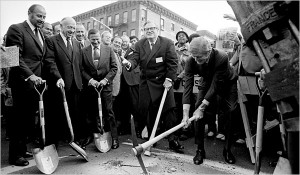
The primary reason that after World War II that the United States built so many highways throughout the nation was that in 1956 President Eisenhower signed the National Defense Highway Act which promised states that the Federal government would pay the states 90 cents on the dollar for the cost of building them, which were normally high and through cities especially high. If they wanted to build a mass transit line the Feds would pay nothing.
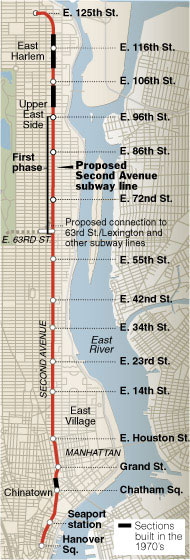
In 1964 this changed. Throughout the 1950s and 60s many people were coming to realize just how destructive building highways were to cities. Not only were neighborhoods often destroyed but, instead of connecting the cities to their suburbs, these new roads were draining cities of the middle and upper classes, on whom cities relied for taxes to pay for the majority of services. In 1950 many cities had all time highs in population but ten years later almost all major industrial cities had lost large percentages of population and future trends pointed to continued loss. In 1964 progressive Democrats were swept into Congress and Lyndon B. Johnson was elected President. President Johnson proposed a wave a new progressive legislation aimed at fighting poverty and building up education, health, and cultural infrastructure, known as the Great Society. One aspect of the Great Society was the Urban Mass Transit Act which promised states 50 cents on the dollar to build mass transit systems. Many aging systems benefited from this act including San Francisco and Washington D.C. which built entirely new systems (BART, Metro).
New York saw an opportunity to finally find financing for the Second Ave subway and in 1967 voters passed a $2.5B bond measure with $600M allotted for the Second Ave subway. The next year the newly formed Metropolitan Transit Authority released its Program for Action in which the agency outlined a massive overhaul of the aging system by upgrading older lines, eliminated the 3rd Ave elevated line which still ran in the Bronx (fun fact: this line was known as the 8 train), capturing Long Island Railroad right-of-ways for new subway lines, and building a scaled down version of the Second Ave subway. The new version would only be a two track line, with Phase 1 running from 126th St to 34th St, connecting to a new crosstown Queens tunnel at 63rd St, and a Phase 2 running from 34th St to Broad St. Future connections would then be made to the Bronx along a rehabilitated Pelham Bay line (6 train) and a new subway along the Metro North right-of-way to Fordham.
In 1972 ground was broken and construction began on small sections at 99th and 105th, 110th and 120th Sts, and between Chatham Sq and Canal St (this section was supposedly destroyed with the construction of Confucius Plaza.) Three years later yet another financial crisis, this time of the city of New York, stopped progress.
A fantastic video from a PBS program in 1975 covers the debate of the day.
Shut off from the world, the only section eventually opened was that of the 63rd St tunnel to Queens. The other small sections were sealed for decades with a politician now and then proposing uses for them. Due to the population decline of the city during the next 20 years and the fragile financial situation of the city and MTA no serious plans were ever brought forth to construct the Second Ave subway.
“The Second Avenue subway is to all intense and purposes dead.” -Carl H. Abraham, New York City Transportation Admin. 1975
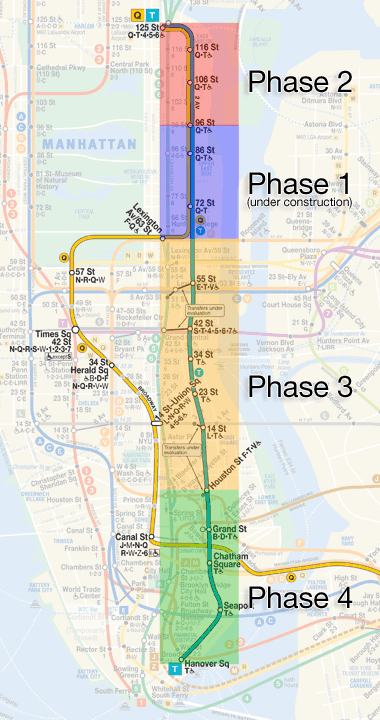
After a generation of decline the city began a rebound in the 1990s. Crime began to drop and the population drain of the previous 30 years began to slow and in some places populations grew with new waves of immigrants. With the future of the city finally looking bright planners once again started looking at ways to improve traffic on the East Side of Manhattan. Some saw a subway as still too expensive, light rail and Bus Rapid Transit were both proposed, but residents demanded that a full subway be constructed. Too much time and money had been wasted and congestion along the Lexington Ave subway was only going to get worse.
In 2001 a plan was put forth to build the subway in phases: Phase 1 would go from 63rd St/Lexington Ave to 96th St/2nd Ave and connect with the Broadway Line (Q train). Phase 2 would continue the subway north to 125th St with future connections available to the Bronx and a cross-Harlem subway under 125th St (though this later proposal was not looked at for immediate planning). Phase 3 would run south from 63rd St, with a connection to Queens, to Houston St. It is presumable that this section of subway would then feed into the Chrystie St Connection to the Manhattan Bridge as the Grand St station (along this section of subway) had, theoretically, been built to allow for easy connection to a future Second Ave subway. Phase 4 would extend the subway south to the Financial District terminating at Hanover Sq. There was a second proposal for Phase 4 which would have connect to the Centre St subway (J,Z) and allow for a simple extension of the subway into Brooklyn, but this was eventually passed on.
Construction began again in 2007, months before yet ANOTHER financial crisis hit the nation. History seemed to want to repeat itself but this time funding for the first phase was already in place (as opposed to pay-as-you-go as with past attempts.) When fully complete the new subway will be called the “T” line, the color a light blue. It will get a letter because it is part of the IND legacy (which has more to do with the size of subway train than it does for nostalgia) which has lettered trains unlike the IRT which uses numbers.
Due to financial reasons (costs have skyrocketed over the years) the current version of the Second Ave subway will only be two track, local service the entire route. For all the foresight subway planners might posses, this seems to me a grave mistake that will come to haunt the city for generations to come. The timeline for the current construction on Phase 1 was supposed to end in 2014 but has now been bumped back to 2016 and will most likely not make that mark. Originally Phase 1 was to include a third track to allow for better switching from the 2nd Ave line to the 63rd St tunnel but this was dropped due to cost.
Given the pace at which the Second Ave subway has progressed it is no wonder that the city and MTA are not planning expanding the system into the Bronx or Brooklyn anytime soon. Up until now this series has been looking back at the expansion plans of the past. From here on out, however, I will be presenting my plan for expanding the system. My next post will look at what a future 2nd Ave subway might look like, where and how it could connect to the other boroughs to create a new backbone for the subway network.
More Information
- Second Ave Subway, Wikipedia
- MTA Second Ave subway Capital Construction
- IND Second System, NYCSubway.org
- Second Ave Subway, NYCSubway.org
- Timeline of Second Ave subway, SecondAveSagas.com
- The Launch Box
- Saga of the Second Ave subway (1975)
- Is That Finally the Sound of a 2nd Ave subway?, NY Times 4/9/07
The futureNYCSubway
- IND Second System
- Post War Expansion
- The Second Ave Subway: History
- The Second Ave Subway: To The Bronx and the Nassau Line
- Brooklyn: Bushwick Trunk Line
- Manhattan: West Side and Hudson Crossings
- Queens: Flushing Trunk Line
- Staten Island: The Last Frontier
- TriboroRX and Atlantic Ave Super-Expre
- Conclusion: the vanshnookenraggen plan

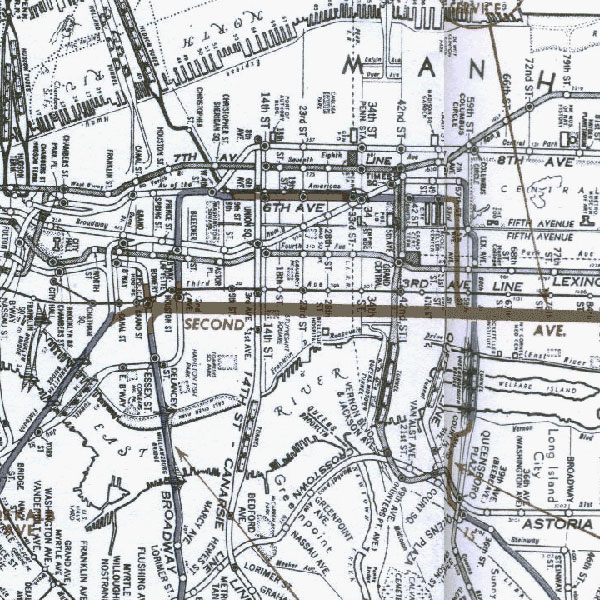

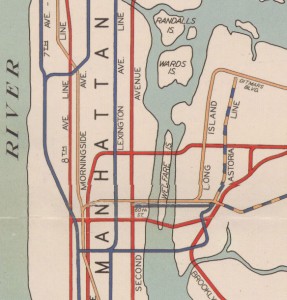
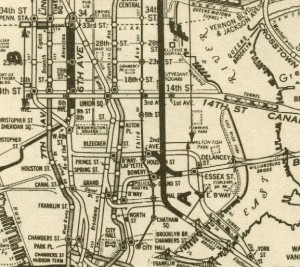
I’m 6 years old and i have an important question for you to answer…
What model subway car is going to be used on the 2nd avenue T line?
R16 R27 R32 R43 R56 R79 R142 R142A R160A R160 ????????????
Thank you for answering me!
Warmely,
Jack
Can’t say I know that, maybe R160? At least that since they are ordering the cars today. I don’t think they will design any special new cars for the T like the Transit Authority did back in the 1950s.
Really enjoyed this article.Thanks Again.
In answering Jack’s question, the type of car that is going to be used for the Second Avenue Subway will be the R160, which is the car currently used on the “Q” line.
I hope this information is very helpful.
I promised my grandson that I will take him for a ride on the brand new Second Avenue subway for his bar-mitzvah. This great event will occur in December 2017. Do I have a realistic hope of fulfilling my promise?